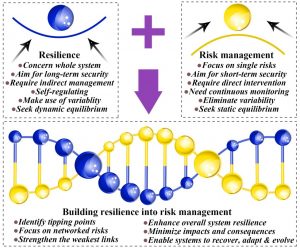The BRIM Network will develop a shared, multi-disciplinary vision of how to build resilience into networked risk management for highly complex engineered systems. We expect to develop a double helix framework that integrates risk and resilience analysis in complex systems (Fig. 1). This framework will be of sufficiently general to manage extreme events for complex systems, though the focus of this project is on critical infrastructure systems under extreme weather.
 Fig. 1 A double helix framework that integrates risk and resilience analysis (developed from Erisman et al. (2015))
Fig. 1 A double helix framework that integrates risk and resilience analysis (developed from Erisman et al. (2015))
Therefore, BRIM will address the challenges encompassed in understanding of complex interdependencies, cascade effects, tipping points of engineered systems through the following three scientific areas of challenge.
1) Risk Analytic Paradigm. Current risk analysis has a narrow focus and cannot address “neglected areas of uncertainty”. This is particularly the case for critical infrastructure when evaluating the impacts under extreme events because both probabilities and impacts are barely quantifiable (Butler et al., 2014). Thus we will reframe the risk narrative and include environmental and socio-economic risks. We will nurture new theoretical frameworks and tools for managing critical infrastructure systems under extreme weather.
2) Global systems science, networked risks and tipping points. The current scientific understanding of large systems is restricted to cases of special, sparse or static systems. In this project, we will advance our understanding on dynamically changing, highly interconnected, and densely populated complex systems, which can have surprising, potentially dangerous system behaviours. We will stimulate research to understand unpredictable and uncontrollable ‘hyper-risks’ or ‘networked risks’ through cascade of failures in systems of systems, to tackle the challenge of linking systemic failure states to stochastic, abrupt perturbations/threats, and to identify tipping points and weakest links that enable early, effective integration of resilience into systems design and management.
3) Design vs. operational resilience, resilience metrics and intervention strategies. We will engage the communities to discuss different metrics of the two types of resilience: system vs. operational resilience, and identify system properties that contribute to improving operational resilience, such as redundancy, modularity, diversity, flexibility, multi-purpose and interconnection. A key challenge is to develop theoretical frameworks that maps system domains to an event management cycle of resilience functions. The interdependencies between complex systems are of particular concern to develop intervention strategies. Decentralised and participatory approaches make use of the positive sides of cascade effects to increase system controllability and could be a way forward (Helbing, 2013).
Reference
Butler D., Farmani R., Fu G., Ward S., Diao K., Astaraie-Imani M., 2014. A new approach to urban water management: Safe and SuRe. Procedia Engineering 89, 347-354.
Erisman J.W., Brasseur G., Ciais P., van Eekeren N., Theis T. L., 2015. Global change: Put people at the centre of global risk management. Nature, 519, 151-153.
Helbing D. 2013. Globally networked risks and how to respond. Nature 497, 51-59.